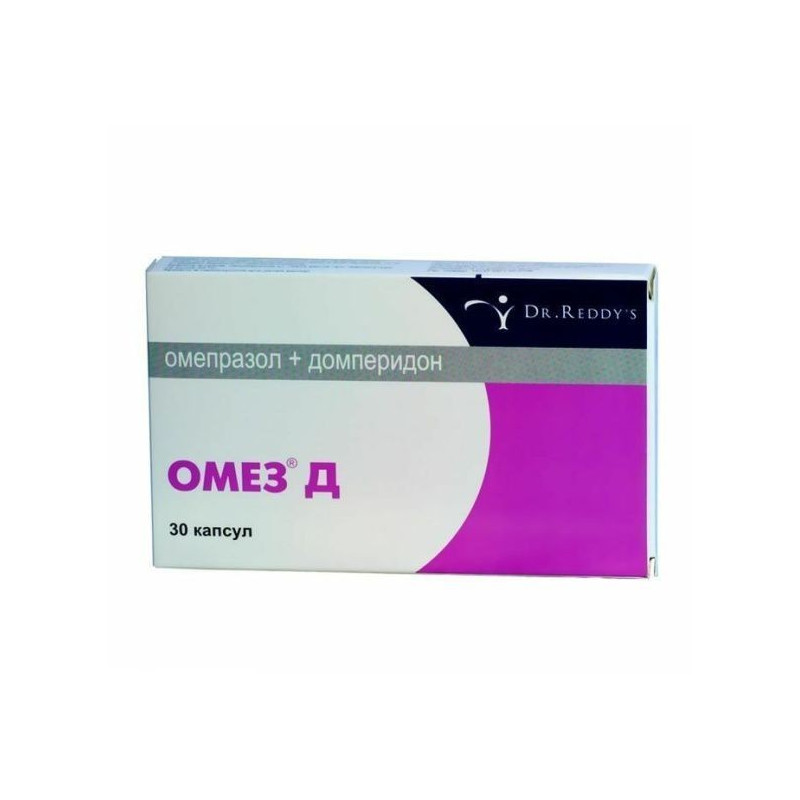



 All payments are encrypted via SSL
All payments are encrypted via SSL
 Full Refund if you haven't received your order
Full Refund if you haven't received your order
OMEZ D KAPS №30
Combined medication, the action of which is due to the components in its composition.
Omeprazole is an anti-ulcer antisecretory agent that reduces spontaneous and stimulated gastric secretion due to inhibition of H + / K + -ATPase (proton pump), necessary for the transport of hydrogen ions, inhibits the final phase of basal and stimulated secretion of hydrochloric acid, regardless of the nature of the stimulus.
Domperidone - dopamine receptor antagonist, prokinetic. Practically does not penetrate the BBB.
Increases the motor-evacuation function of the stomach and duodenum and the tone of the lower esophageal sphincter. Does not increase the secretion of the glands of the digestive tract. It has antiemetic effect.
Omeprazole is rapidly and completely absorbed in the gastrointestinal tract after oral administration on an empty stomach; when taken after meals, absorption may increase. Although the half-life of Omeprazole is short (0.5–1.5 hours), the antisecretory effect lasts for ≥24 hours. Omeprazole rapidly (over 4 hours) spreads in the gastric mucosa, liver and gallbladder tissues. After 48 h, omeprazole is determined only in the gastric mucosa.
Approximately 90–95% of omeprazole binds to plasma proteins. A small amount penetrates through the BBB.Most (77%) are excreted in the urine as metabolites (of which hydroxyomeprazole and the corresponding carboxylic acid are identified).
The remaining amount is excreted in the feces (a significant part of the metabolites excreted in the bile).
Three metabolites of omeprazole are identified in blood plasma - sulfide and sulfone derivatives of omeprazole. They have weak antisecretory activity or do not possess at all. The active metabolite is sulfoneprazole.
In patients with chronic liver diseases, the bioavailability of the drug is increased to 100%, and the half-life is increased to 3 hours. In patients with chronic kidney disease and in elderly patients, the elimination of omeprazole decreases in proportion to the decrease in creatinine clearance, and the concentration in blood plasma increases.
Domperidone after taking well absorbed in the digestive tract. Intensive metabolism takes place in the wall of the stomach and liver, has a low bioavailability (15%). The maximum plasma concentration of blood is achieved within 1 h after application. Reducing the acidity of gastric juice reduces the absorption of Domperidone. Associated with plasma proteins at 91–93%. Excreted in the feces (66%) and urine (33%). The half-life is 9 hours, with severe renal failure increases.
Functional dyspepsia, delayed evacuation of gastric contents and gastroparesis, reflux esophagitis, gastric and duodenal ulcer, as part of eradication therapy in the presence of Helicobacter pylori.
Capsules are ingested whole, not breaking and not chewing.Dose set individually based on the course of the disease. The average recommended dose for adults is 1 capsule 2-3 times a day 30 minutes before meals with a glass of water. If necessary, in case of exacerbation of the disease, the dose can be increased to 2 capsules 2 times a day. The course of treatment is 4-8 weeks.
In the schemes of eradication therapy, 2 capsules are prescribed 2 times a day in combination with antibacterial agents.
Hypersensitivity to the components of the drug, Gastrointestinal bleeding, mechanical intestinal obstruction, perforation of the stomach or intestines, prolactinoma, the period of pregnancy and lactation, age up to 12 years.
Most patients tolerate the drug well. With prolonged use, skin reactions can occur (skin rash, itching, urticaria, polymorphic erythema), dry mouth, diarrhea, constipation, intestinal colic, headache, photosensitization, alopecia, angioedema, dizziness, parasthesia, drowsiness, sleeplessness, blurred vision, impaired taste, agitation, depression, leukopenia, thrombocytopenia, pancytopenia, agranulocytosis, myalgia, arthralgia, bronchospasm, interstitial nephritis, very rarely - galactorrhea, gynecomastia. Domperidone may cause extrapyramidal reactions, especially in patients of young and old age.
Before and after the completion of Omez D therapy, an endoscopic examination is necessary to exclude the malignant process, because treatment with omeprazole can mask its symptoms and delay the correct diagnosis.
During pregnancy, the drug is used if the intended benefit to the mother outweighs the potential risk to the fetus. If necessary, the appointment of the drug during lactation breastfeeding is desirable to stop.
During drug treatment, special care should be taken when driving or working with potentially dangerous machinery.
Antacid drugs slow down and reduce the absorption of the drug, so they must be taken no earlier than 2 hours after taking Omez D.
Since omeprazole is metabolized in the liver through the cytochrome P450 system, it should be carefully administered simultaneously with diazepam, phenytoin, Warfarin, propranolol, prednisolone, theophylline (while omeprazole can reduce their elimination, which requires lower doses of these drugs). With the simultaneous use of omeprazole and Clarithromycin, their concentration in the blood plasma increases.
Cimetidine and sodium bicarbonate reduce the bioavailability of domperidone.
Anticholinergic drugs neutralize the effect of domperidone.
Symptoms: drowsiness, disorientation, extrapyramidal disorders.
Treatment: gastric lavage, the appointment of Activated carbon, to eliminate extrapyramidal disorders - blockers of cholinergic receptors.
In a dry, dark place at temperatures up to 25 ° C.
